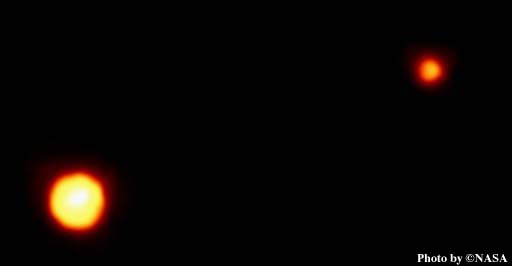|

QueSPER Research Projects
Planets in the Solar System
Dwarf Planets
Pluto
Pluto Pluto Pluto
QueSPER Research Plan and
Note-taking Worksheets
 |
|
Pluto and Pluto's Moon Charon
|
Pluto
Printout
Pluto was discovered
in 1930 and was considered a planet until August, 2006. Now Pluto is considered
a dwarf planet.
 |
How far is Pluto
from the Sun?
 |
Pluto is 3.6
billion miles from the sun. |
 |
Pluto is
5.9 billion kilometers from the sun.
|
 |
The nearest
planet to Pluto is Neptune. |
 |
Pluto has a
strange orbit that sometimes makes it closer to the Sun than Neptune. |
 |
Pluto is in
a group of ice structures known as the Kuiper belt. |
|
 |
How big is Pluto? (What is its diameter?)
 |
Pluto is
less than 1/5 the size of the Earth. |
 |
Pluto's
diameter is 1,430 miles or 2,290 kilometers. |
|
 |
What is Pluto like?
 |
Pluto is
made of rock and water ice and frozen methane (a gas). |
 |
Pluto is
very cold. Its temperature ranges between -369° and -387° F. |
 |
Pluto has
three moons. Their names are
Charon,
Nix
and Hydra. |
 |
Pluto was
the first object discovered in the Kuiper belt. |
|
 |
Why is this
dwarf planet named Pluto?
 |
Pluto is
named for the Roman god of the Dead, Pluto.
Pluto was discovered
in 1930 by Clyde Tombaugh (1906-1997). Astronomers noticed that the orbits
of Neptune and Uranus were being affected by the gravity of an unknown
object in our solar system. Clyde Tombaugh carefully studied images of the
night sky and after a lot of hard work he finally discovered the
Pluto. Clyde Tombaugh was only 24 years old when he made this discovery.
|
|
 | Can we see Pluto in the
night sky?
 | Not without a telescope. It is too far
away and too small. |
|
*One AU is the distance from the center of the Earth to the center of the
Sun.
Information on this page was taken from the following websites:
The-Solar-System.Net
Links to Other
Sites
Books and References
 |
| Time for Kids Almanac 2003 with
Information Please. NY: Time for Kids Books, 2002. |
RL 4.5 |
Dewey 031.02 |
|
 |
| Farndon, John. The Giant Book
of Space. Brookfield,CT: Copper Beech Bks, 2000. |
RL 4.5 |
Dewey 523.4 |
|
"The Solar System 12/2006: 8 Planets; The New Cosmic
Order." Map Insert. National Geographic Magazine. Dec., 2006.
Other Links to Sites
The Nine Planets

 to QueSPER Online to QueSPER Online
|
![]()
 Pluto
Pluto
![]()
 /
/